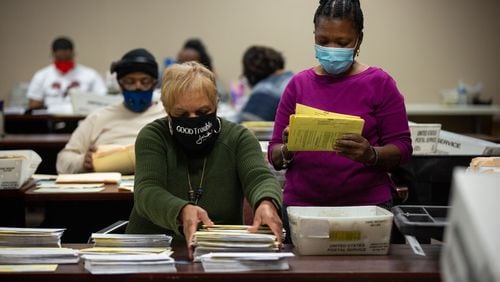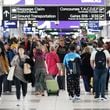DETROIT — As segments of society reopen and the world rushes to get vaccinated, more Americans may lose their fear of flying and once again crowd airports and airplanes.
But those still wary of catching COVID-19 may wonder: Is taking a train safer?
Amtrak doesn’t directly make that claim on its website. But the rail system’s officials have posted videos that agree with prominent experts on viral transmission: Amtrak trains are likely safer than planes for avoiding the deadly virus.
Amtrak rider Erin Silverman of Bloomfield Hills got off the train on the night of Feb. 5 in Troy, after riding the rails all the way to and from Denver. Silverman is a travel agent, operating a Cruise Planners franchise from her home. She said she was impressed with Amtrak’s COVID-19 precautions.
“They were very serious about having people wear masks. They announced several times, you must wear the mask over your nose and mouth or we can kick you off,” she said.
Another safety factor? Airline seating is much more confined than the seating on Amtrak cars, Silverman said.
“Delta is the only airline that is still blocking the middle seat. All the others have people right next to you,” she said. In contrast, Amtrak conductors “were very strict about keeping everyone socially distanced.” Silverman called her trip “a relaxing way to travel.”
In late January, airline executives and employees told reporters they welcomed a new executive order by President Joe Biden, who ordered mask-wearing on all airplane flights as well as on other public transit that crosses state lines. Biden’s order came after months of sporadic voluntary enforcement of mask-wearing by airlines and after a petition from Consumer Reports magazine, signed by more than 60,000 people, demanding a government rule for masking up during flight.
Yet, Amtrak mandated masks for all passengers and employees beginning last spring. At the same time, the rail service announced that it would begin strictly monitoring where passengers sit and how many board each car.
“In 2019, we were selling every seat — now we’re filling only half of each train’s capacity, and we’re strongly encouraging people to sit apart,” said Marc Magliari, spokesman for Amtrak.
Also, Magliari said: “We have significantly more spacing (than airlines and buses) between our seats. We have no middle seats, so each passenger either is seated beside a companion or you have an empty seat next to you.”
Trains also are safer than planes, in part, because many train stations have open-air platforms where travelers board, Dr. Aaron Rossi told USA Today in October. That’s far less risky than the indoor settings of airport security lines and waiting areas where passengers gather and sit before boarding. Rossi is a medical doctor in Pekin, Illinois, and CEO of Reditus Laboratories, a company that conducts COVID-19 testing.
Amtrak’s ridership hit an all-time record nationwide in 2019, then skidded by about 90% in April when cases of COVID-19 began soaring. Since then, ridership crept partway back to its pre-pandemic level while Amtrak operated fewer trains and strictly enforced social distancing in coaches that could carry twice as many passengers.
Amtrak was created by the Congress in 1971 when the nation’s existing railroads said they’d no longer carry passengers. For decades since, the system struggled to get funding and to upgrade service on key routes like the Wolverine, Amtrak’s line that links Chicago to Detroit, then runs north through Oakland County to Royal Oak, Troy and Pontiac.
For decades, improvements crept at the pace of a freight train inching through a switchyard. Despite the release of a report in 1985 called “Detroit-Chicago Corridor: High Speed Rail,” nothing much changed. Then, in 2009, Amtrak installed a new high-tech safety system on 97 miles of track it owns in western Michigan reaching into Indiana. Those improvements allowed all Amtrak trains in that stretch to bump up their speeds. Since 2012, they’ve rolled as fast as 110 mph there.
About five years ago, with ridership rising after the Great Recession ended, Amtrak launched a long-awaited modernization effort. Finally, the signals of change are growing obvious. Despite the setback of the pandemic, riders can climb aboard not only what Amtrak touts as a safer mode of travel, but also one that’s improving.
In Michigan, a clear example is a batch of recently upgraded locomotives and soon-to-arrive, new passenger cars. On Jan. 25, a test train with no passengers pulled new coaches from Chicago to Pontiac, then back again to Chicago on Jan. 26. The new coaches, built in the U.S. by the German multinational company Siemens, will be pulled by almost-new Siemens Charger locomotives, which Amtrak began introducing in the Midwest in 2018 and 2019, according to Amtrak officials.
Siemens says these SC-44 Charger locomotives have a top speed of 125 mph, although they can’t roll nearly that fast just yet between the Motor City and the Windy City. Each is said to boast a 4,400-horsepower diesel engine made by manufacturer Cummins in Indiana, which generates electricity that powers four electric motors to turn the drive wheels. According to online data, these locomotives burn about 10% less diesel fuel per mile than the old engines they are replacing and spew far less pollution, reducing by about 90% the two banes of diesel exhaust — oxides of nitrogen and particulate matter, the diesel “soot” that’s noxious to human lungs.
The new cars could be put into service as soon as this spring, said Michael Frezell, a spokesman for the Michigan Department of Transportation, which purchased the cars and owns much of the track Amtrak uses between Detroit and Chicago.
So, what’s holding back higher speeds across Michigan? The need to extend safety systems and upgrade more track, officials said.
East of Kalamazoo, where the track needs improving, Amtrak’s maximum speed is 79 mph. Amtrak hopes this slower stretch of track, owned by MDOT since 2012, can be upgraded by the end of 2022. When that happens, Amtrak could reach its potential to consistently outshine the experience of driving a car from Detroit to Chicago with lower costs, less time and more convenience — not to mention no fear of getting a dreaded three-figure parking ticket in Chicagoland.
Last spring, Amtrak reduced its Wolverine service from three round trips daily to just one a day between Pontiac and Chicago. Running on normal schedules are Amtrak’s other Michigan trains — the Blue Water service that links Chicago to Battle Creek, Lansing, Flint and Port Huron; and the Pere Marquette between Chicago and Grand Rapids.
A looming question is whether once most Americans are vaccinated and people begin to return to flying, can Amtrak maintain its momentum and rebuild its ridership to pre-pandemic levels, then keep it growing. All of that may, literally, require an act of Congress.
Last year, the rail system’s executives — along with their boosters in the nonprofit Rail Passengers Association — had hoped to cap their record-breaking 2019 ridership with a crucial win in the U.S. Congress, at last giving Amtrak the legal clout for its trains to take precedence over the freight trains that it says so often cause delays. With COVID-19′s onrush, that hope was shunted to a political siding.
Federal law says freight trains must yield to passenger trains when both want to use the same track. However, too often, freight operators ignore the rule, according to Amtrak.
A Free Press article last year documented that Amtrak’s trains had become routinely late across much of the nation, with Michigan trains the very latest. Nationwide, Amtrak was on time only 60% to 70% of the time in many states in 2019. And in Michigan, the on-time rate was just 43%. Even worse, on the popular route from Chicago to Detroit to Pontiac, on-time performance occurred just 33% of the time. Amtrak officials documented the late arrivals with detailed records of “freight train interference,” showing a chronic problem of passenger trains being forced to wait while freight trains crawled ahead.
In a letter dated Jan. 22, Amtrak CEO Bill Flynn, who took the top job last spring, sent a letter to each member of Congress, citing Amtrak’s 50th anniversary this year. Flynn asked for “a predictable and long-term source of federal funding” to continue modernizing the system.
But more money, to buy faster locomotives and sleek new cars on upgraded track, can’t do much for train travelers if a poky freight train blocks their way. So Flynn also asked Congress to give Amtrak the right to sue freight rail operations in federal court, “so we can ensure our customers are not unnecessarily delayed by freight trains, and arrive on time.”
If the lawmakers see it Amtrak’s way, many more travelers may ride the rails for reasons other than COVID-19 concerns.





